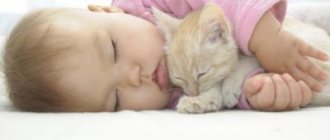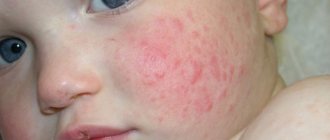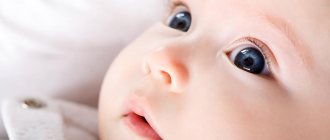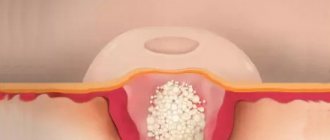Last updated: July 24, 2020
Allergic rashes in children are a very common and common occurrence. Most often, this disease manifests itself in the form of a rash, but the causes can be different. You will learn in this article how allergic rashes in children are treated and what they are like.
- For what reason does an allergic rash appear on a child's skin?
- What does a child's skin allergy look like?
- How to diagnose allergies?
- First aid and treatment
- What is done to prevent allergic rashes in children?
- Types of allergic reactions with photos
- Conclusion
Causes
Allergic rashes can occur in children from birth until the age of 7 years. This is explained by the fact that the immune system has not yet been formed. Below are the main causes of allergic reactions in children:
- Medicines, the body may react negatively to some components of medicines;
- Breast milk if the diet is not followed;
- Hygiene products and household chemicals;
- Plants and animals can also cause rashes;
- Ultra-violet rays;
- Various infections and diseases.
Causes of allergies in children
Before identifying an allergy in a child, it is necessary to understand its causes.
Firstly, this disease is considered hereditary. That is, children with allergies are more likely to be born to parents with the same disease than without it.
Often in everyday life, childhood allergies are called “diathesis.” If a child eats too many tangerines and the next day walks around with red, itchy cheeks, they say he has diathesis. In fact, “diathesis” is not a disease at all, but simply a tendency of the body to any disease. In addition, there are types of diathesis that indicate a tendency to diseases of the cardiovascular or nervous system, but that is a completely different story.
In the case of tangerines, exudative-catarrhal diathesis occurs, that is, a person’s tendency to allergic reactions. In a child with a still developing organism, this tendency is naturally much stronger than in an adult. That is, the baby needs to be saved not from the mythical disease “diathesis”, but from contact with certain substances and products.
So why does a child develop allergies? The main catalysts of the disease are:
- Food products - especially those with the addition of chemical dyes and preservatives, spices and flavors, as well as exotic fruits and other products not typical for our climate zone. And also a non-standard reaction of the body can be caused by: fish, nuts, eggs, mushrooms, chocolate, legumes, beets, carrots, cow's milk protein
- Dust and dirt. Surprisingly, children can play outside as much as they want, launching boats in spring streams, but house dust can quickly cause a runny nose, red eyes, or itchy skin.
- Plant pollen is one of the most common allergens not only in children, but also in adults. The disease begins to worsen in spring and summer during flowering plants or on vacation, where the child encounters many unknown trees and flowers.
- Animal fur is a very personal touch. Some children can sleep cuddled with a Labrador, and some begin to sneeze and itch simply from the presence of an animal in the house.
- An allergy to cats is a separate issue, since a negative reaction can be caused not only by animal fur, but also by substances contained in their secretions. We may not smell or see cat tracks, but a child’s delicate body instantly reacts to the presence of these substances in the air.
- Insect bites - something that will cause only a slight painless redness in an adult, can turn into a serious allergy on the child's skin for a baby.
- Chemicals are one of the most popular and difficult to identify causes of childhood allergies. This could be synthetic clothing materials or poorly rinsed floor cleaner, some components of creams, or low-quality plastic toys.
- Cold. A sensitive child's body can react unpredictably to low temperatures, while an adult will not notice any unpleasant sensations. External signs of a reaction to cold are swelling in exposed areas of the skin, whitening or redness, as well as peeling and itching even after a short stay outside.
What do allergic rashes look like?
There are a large number of types of allergy rashes in children, it all depends on the irritant that caused it. In many cases, exanthemas appear on the child’s body (this is the name given to various manifestations of allergic rashes):
- pustules (filled with pus);
- plaques;
- spots;
- vesicles (filled with liquid);
- blisters (large vesicles larger than 0.5 cm).
With food allergies in children, the rash can be found primarily on the cheeks and near the mouth. With a contact allergy, a rash or irritation will appear in the area where the allergen touched. If the child’s body reacts negatively to medications, inflammation will appear in the area of the lymph nodes.
Allergy symptoms in children
Each form of allergy has specific symptoms. What allergies look like in children of different age categories will be discussed below.
Atopic dermatitis is characterized by:
- Itching.
- Typical rash: for young children - redness, nodules, blisters localized on the face and extensor surfaces of the extremities. For older children - nodules, dry skin on symmetrical areas of the flexor surfaces of the limbs.
- Chronic relapsing course.
- Onset of the disease at an early age (usually before 2 years of age)
- Family history of allergies.
Symptoms such as:
- Dry skin.
- Tendency to skin infections.
- Localization of inflammation on the hands and feet.
- Inflammation of the eyes (conjunctivitis).
- Dark circles around the eyes.
- Itching when sweating, etc.
of allergic rhinitis include:
- Itchy nose.
- Sneezing.
- Discharge from the nose.
- Children constantly scratch their nose and wrinkle it.
- Dark circles around the eyes.
- There may be itching of the eyelids and watery eyes.
- Increased sensitivity to cooling, dust, strong odors.
Bronchial asthma in children is manifested by symptoms such as:
- Periodically recurring attacks of suffocation. The attack most often develops at night. The child has difficulty breathing (it is difficult to exhale). The baby takes a forced position in bed - sitting with support from his hands. Noisy wheezing is also characteristic.
- In young children, the main manifestation may be a whistling prolonged exhalation, as well as a wet paroxysmal cough with sputum that cannot be coughed up.
The development of urticaria and angioedema is accompanied by the development of symptoms such as:
- Feeling hot.
- Skin itching.
- Skin changes, like after a nettle burn. The rash can be of different sizes, have a variety of shapes, and often merge with each other. The color of the rash ranges from pale pink to red. The rash can be located on any part of the body and mucous membranes. Most often on the stomach, back, chest, hips.
- Fever, increased excitability of the baby.
- With the development of Quincke's edema, limited swelling in the area of the lips, ears, neck, hands, feet, and upper respiratory tract is characteristic.
Urticaria and angioedema are dangerous and serious conditions.
Having examined the main clinical manifestations of allergies in children, let’s move on to considering the treatment of these pathological conditions.
How to diagnose allergies?
An allergic rash in children is often confused with an infectious one. If the treatment is incorrect, then the consequences of such a therapeutic course will not be the best. Before choosing an effective remedy, you need to learn to distinguish one disease from another. Only a doctor can make an accurate diagnosis, since a visual examination is not always enough to determine the cause of the disease; tests are required.
| Features | Allergic rash | Infection |
| General form | It can be in the form of both small dots and large blisters. In addition to them, there are often crusts, erosions and serous wells (ulcers from which fluid oozes). | The rashes are pinpoint and do not “merge” into a large spot. |
| Place of appearance | Face (forehead, cheeks, chin). Neck, arms, legs, buttocks. Rarely – stomach, back. | Belly, back. Rarely – arms, legs. Very rarely - forehead. |
| Heat | The temperature is rare, and if it rises, it is not higher than 37-38°C. | The disease is accompanied by fever, from 37°C to 41°C. |
| Itching | Happens. | Happens. |
| Swelling | Well visible. In some situations it is life-threatening. | They happen very rarely. |
| Associated symptoms | Lacrimation, conjunctivitis, hyperemia of the mucous membrane of the eye, decreased blood pressure, cough, upset stomach. | Running nose, general loss of strength, body aches. |
| How quickly it goes | Often the rash goes away immediately after taking the medicine. | Remains until the course of treatment is completed. |
Treatment of allergies in children
Treatment of allergies in children has a number of common features. The fact is that the drugs used to treat allergies in children belong to the same groups. Parents often ask the question: “How to treat allergies in a child?” Next, we will consider the treatment of allergies in a newborn child, an infant and older children. The most common groups for allergy treatment are:
- Hormones . This refers to the use of glucocorticosteroids, which have the most pronounced antiallergic effect. They are available in the form of ointments, sprays, inhalers, solutions for inhalation, tablets, ampoules for intramuscular and intravenous administration. For atopic dermatitis, local glucocorticosteroids are used in the form of ointments and creams. These include: elocom, celestoderm, lokoid, cutivate, dermovate. For allergic rhinitis, preference is given to local inhaled glucocorticosteroids: Nasonex, Avamis. They have a good effect in the treatment of seasonal allergies in children to flowering plants. With the development of bronchial asthma, inhaled glucocorticosteroids (ICS) are used for constant basic treatment: fluticasone, pulmicort. Systemic hormones – prednisolone – can be used. It is worth noting that in addition to treatment with hormones, for bronchial asthma in some cases it is possible to use cromones (Tyled, Intal) and leukotriene modifiers (akalate, montelukast). They also have an antiallergic effect and help prevent the development of attacks in children with asthma. For urticaria and Quincke's edema, hormones are administered immediately by intramuscular and intravenous injections. Preference is given to a 3% prednisolone solution; dexamethasone can also be used.
- Antihistamines. They have a less pronounced effect, but have fewer side effects and contraindications. The essence of the action of these drugs is to block histamine receptors. This eliminates the effect of histamine. Histamine is a mediator of inflammation, that is, a substance that triggers allergies. They exist of different generations. First generation drugs include: diphenhydramine, tavegil, diazolin, suprastin, etc. They have side effects - sedative (hypnotic, sedative). It is worth highlighting suprastin. One of the most common drugs in this group. Has a pronounced antihistamine effect. It is available both in tablet form and as an injection solution, which allows it to be used to relieve acute allergic reactions. Second-generation drugs include: fenistil, allergodil, loratadine, etc. Among third-generation drugs, it is worth highlighting: Zyrtec, Telfast. Antihistamines are available in various forms: tablets, syrups, injection solutions. For atopic dermatitis and allergic rhinitis, tablets are often used. In young children it can be used in the form of syrup. For acute allergic reactions (urticaria, Quincke's edema), injection solutions are used. It is worth noting that this group of drugs is used to treat allergies even in a month-old baby.
- Sorbents . They do not have a direct antiallergic effect, but indirectly have this effect. Allows you to remove allergens that cause allergies from the intestines. It is very important to use these drugs at certain times in relation to other drugs, as they can interfere with their absorption and, therefore, reduce the concentration of these drugs in the blood. Among the drugs in this group it is worth noting: enterosgel, atoxil, polysorb, sorbex, lactofiltrum.
To choose the right treatment tactics, consult a doctor.
First aid and treatment
If children develop an allergic rash on their skin, it is strictly forbidden to squeeze pimples or open blisters. It is necessary to explain to the child that it is also forbidden to scratch the sores.
If he is still too small, make sure that he does not touch the wounds with dirty hands. He can get an infection, and this will only worsen his condition.
Treatment of rashes in children is selected depending on the type of disease. Parents who do not know how to treat allergic rashes in children should not select medications on their own.
How does an allergy manifest itself?
Allergy symptoms vary depending on what your child is allergic to. Airborne allergens such as pollen commonly cause hay fever (allergic rhinitis). Children with hay fever may have seasonal symptoms with a runny nose, itchy nose or eyes, and sneezing during the flowering season. Children with dust mite allergies may have year-round "hay fever" with a runny or stuffy nose and sneezing, often worse in bed. Airborne allergens can also contribute to the development of asthma and eczema symptoms.
Children with food allergies most often develop allergy symptoms when they eat foods to which they have developed an immune system overreaction. Symptoms of food allergies may include skin rashes (such as hives), swelling of the face, lips, and eyes, as well as stomach pain, vomiting, and diarrhea. Some children may have a severe reaction with breathing problems (such as coughing and wheezing) or collapse. This is called anaphylaxis and can be life-threatening.
If a child has a food allergy, touching the food is unlikely to cause a serious allergic reaction. Some skin rashes may appear on the part of the skin that was touched. Being in the same room with food is also unlikely to cause a reaction. But cooking and fumes from certain foods, such as eggs or fish, can cause a reaction in some particularly sensitive people.
How to avoid allergies in children?
Preventive measures will prevent the child from developing an allergic rash. Doctors give the following recommendations:
- Make sure that the baby does not come into contact with the allergen (remove allergenic foods from his diet; if necessary, change baby powder, soap or dishwashing liquid.
- Maintain order in his room, regularly do wet cleaning.
- If there are pets in the house, keep them clean.
- Strengthen the baby’s immunity (walk more often, play sports).
- Do not violate your doctor’s recommendations for taking medications.
How to distinguish a cold from an allergy in a child
A cold goes away within 10 days at the latest, but allergies appear constantly.
Here are the obvious signs of an allergy:
- the child constantly sniffles, especially if the nasal discharge is clear and liquid, and not yellow or green and thick;
- the baby constantly sneezes, his eyes are red, wet and itchy;
- the child has dark circles under his eyes, his nose is constantly stuffy, and he breathes through his mouth;
- dry cough;
- the skin is inflamed, red and itchy.
Examples of rashes with photos
Colorless rash "goosebumps"
Exudative diathesis
Hives
Food allergies
Prevention and prognosis of the development of allergies in children
Unfortunately, there are no methods to completely cure allergic diseases. If we are talking about “recovery,” most likely there is a long-term clinical remission. The success of treating such children largely depends on early diagnosis of the pathological condition and adequate treatment. According to the epidemiological study ISAAC (International Study of Asthma and Allergy in Childhood), about 10% of the world's population suffers from allergic diseases. Considering such a high prevalence of this pathology, the steady growth and progression of this pathology, the attention of parents should always be increased. Do not self-medicate; at the first manifestation of an allergy in your child, consult a doctor who will help you cope with your illness.









